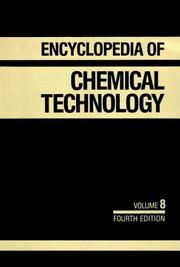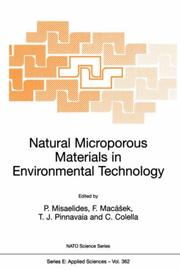| Listing 1 - 10 of 14 | << page >> |
Sort by
|
Book
Year: 1958 Publisher: Xenia, Ohio : W. A. Hammond Drierite Company,
Abstract | Keywords | Export | Availability | Bookmark
 Loading...
Loading...Choose an application
- Reference Manager
- EndNote
- RefWorks (Direct export to RefWorks)
Book
ISBN: 953515382X 9535111515 Year: 2013 Publisher: IntechOpen
Abstract | Keywords | Export | Availability | Bookmark
 Loading...
Loading...Choose an application
- Reference Manager
- EndNote
- RefWorks (Direct export to RefWorks)
Molecular Toxinology has been consolidated as a scientific area focused on the intertwined description of several aspects of animal toxins. In an inquiring biotechnological world, animal toxins appear as an invaluable source for the discovery of therapeutic polypeptides. Animal toxins rely on specific chemical interactions with their partner molecule to exert their biological actions. The comprehension of how molecules interact and recognize their target is essential for the rational exploration of bioactive polypeptides as therapeutics. Investigation on the mechanism of molecular interaction and recognition offers a window of opportunity for the pharmaceutical industry and clinical medicine. Thus, this book brings examples of two interconnected themes - molecular recognition and toxinology concerning to the integration between analytical procedures and biomedical applications.
Molecular sieves. --- Chemical engineering --- Drying agents --- Sieves --- Sorbents --- Medical toxicology
Periodical
ISSN: 18733115 Year: 1981 Publisher: Guildford, England : IPC Science and Technology Press
Abstract | Keywords | Export | Availability | Bookmark
 Loading...
Loading...Choose an application
- Reference Manager
- EndNote
- RefWorks (Direct export to RefWorks)
Zeolites --- Molecular sieves --- Chemical engineering --- Drying agents --- Sieves --- Sorbents --- Silicate minerals --- Molecular sieves. --- Zeolites.
Periodical
ISSN: 18733093 13871811 Year: 1998 Publisher: New York : Elsevier Science,
Abstract | Keywords | Export | Availability | Bookmark
 Loading...
Loading...Choose an application
- Reference Manager
- EndNote
- RefWorks (Direct export to RefWorks)
Molecular sieves --- Zeolites --- Porous materials --- Porosity --- Tamis moléculaires --- Zéolites --- Porosity. --- Zeolites. --- Molecular sieves. --- Porosities --- Zeolite --- Silicate minerals --- Chemical engineering --- Drying agents --- Sieves --- Sorbents
Book
ISBN: 0471919810 Year: 1988 Publisher: Chichester
Abstract | Keywords | Export | Availability | Bookmark
 Loading...
Loading...Choose an application
- Reference Manager
- EndNote
- RefWorks (Direct export to RefWorks)
Surface chemistry --- fysicochemie --- Materials sciences --- Fysicochemical separation methods --- Moleculaire zeven --- Zeolieten --- Analytische chemie --- 553.679 --- 544.726 --- Molecular sieves --- Zeolites --- Silicate minerals --- Chemical engineering --- Drying agents --- Sieves --- Sorbents --- Sols --- Minéralogie

ISBN: 0471526762 Year: 1992 Volume: 8 Publisher: New York ; Brisbane ; Singapore Wiley
Abstract | Keywords | Export | Availability | Bookmark
 Loading...
Loading...Choose an application
- Reference Manager
- EndNote
- RefWorks (Direct export to RefWorks)
Chemical technologies --- Chemistry, Technical. --- ENCYCLOPEDIAS --- Chemical technology --- Industrial chemistry --- Technical chemistry --- Chemistry --- Technology --- Chemical engineering --- Monograph --- ISOTOPES --- WATER --- DIALYSIS --- AMINES --- KIESELGUHR --- DICARBOXYLIC ACIDS --- DIETARY FIBER --- DIFFUSION --- DIMENSIONAL ANALYSIS (NOT CAS) --- FATTY ACIDS, POLYMERS --- ANTIBACTERIAL AGENTS --- DISPERSION (OF MATERIALS) --- DISTILLATION --- DIURETICS --- DRYING AGENTS --- CONTROLLED-RELEASE DRUG DELIVERY SYSTEMS --- DYES --- ANTHRAQUINONE DYES --- REACTIVE DYES --- ECONOMICS --- EGGS (FOOD) --- RUBBER, SYNTHETIC --- LIGHT --- CHEMICAL AND PHYSICAL EFFECTS

ISBN: 0792358880 0792358899 9401144990 Year: 1999 Volume: 362
Abstract | Keywords | Export | Availability | Bookmark
 Loading...
Loading...Choose an application
- Reference Manager
- EndNote
- RefWorks (Direct export to RefWorks)
Clay minerals --- Kleiachtige mineralen --- Mineraux argileux --- Civil & Environmental Engineering --- Engineering & Applied Sciences --- Environmental Engineering --- Molecular sieves --- Congresses --- Zeolites --- Layer structure (solids) --- Air pollution. --- Earth sciences. --- Atmospheric Protection/Air Quality Control/Air Pollution. --- Earth Sciences, general. --- Geosciences --- Environmental sciences --- Physical sciences --- Air --- Air contaminants --- Air pollutants --- Air pollution --- Air pollution control --- Air toxics --- Airborne pollutants --- Atmosphere --- Contaminants, Air --- Control of air pollution --- Pollutants, Air --- Toxics, Air --- Pollution --- Air quality --- Atmospheric deposition --- Control --- Chemical engineering --- Drying agents --- Sieves --- Sorbents
Book
ISBN: 9811004382 9811004404 Year: 2016 Publisher: Singapore : Springer Singapore : Imprint: Springer,
Abstract | Keywords | Export | Availability | Bookmark
 Loading...
Loading...Choose an application
- Reference Manager
- EndNote
- RefWorks (Direct export to RefWorks)
This book explores the improvement in thermal insulation properties of protein-based silica aerogel composites fabricated by a novel, inexpensive and feasible method. The resulting material exhibits polymeric foam behavior including high compressibility, super-hydrophobic qualities and excellent strain recovery in addition to low thermal conductivity. The fabrication methodologies are explained in great detail and represented in flowcharts for easy reference and understanding. This monograph gives readers a new perspective on composite fabrication using methods other than the traditional ones and explores the endless ways of altering the composition to modify the properties of the silica aerogel composites. Applications for this novel composite are diverse and range from those in the pharmaceutical and aerospace industries to the oil and gas industries.
Materials Science --- Chemical Engineering --- Chemical & Materials Engineering --- Engineering & Applied Sciences --- Silica gel. --- Aerogels. --- Colloids --- Drying agents --- Ceramic materials --- Polymers. --- Ceramics, Glass, Composites, Natural Materials. --- Materials Engineering. --- Polymer Sciences. --- Polymere --- Polymeride --- Polymers and polymerization --- Macromolecules --- Ceramics. --- Glass. --- Composites (Materials). --- Composite materials. --- Engineering—Materials. --- Polymers . --- Ceramic technology --- Industrial ceramics --- Keramics --- Building materials --- Chemistry, Technical --- Clay --- Composites (Materials) --- Multiphase materials --- Reinforced solids --- Solids, Reinforced --- Two phase materials --- Materials --- Amorphous substances --- Ceramics --- Glazing
Book
ISBN: 0120793504 Year: 1978 Publisher: London ; New York : Academic Press,
Abstract | Keywords | Export | Availability | Bookmark
 Loading...
Loading...Choose an application
- Reference Manager
- EndNote
- RefWorks (Direct export to RefWorks)
Molecular sieves. --- Sorbents. --- Zeolites. --- Clay minerals. --- 661.183.1 --- 549.67 --- 66.067.32 --- Clay minerals --- Molecular sieves --- Sorbents --- Zeolites --- Silicate minerals --- Absorption --- Adsorption --- Chemical engineering --- Drying agents --- Sieves --- Minerals, Clay --- Rock-forming minerals --- Adsorbents with special properties. Ion-exchangers. Cationic and anionic exchangers --- Filters with other media. Filters with granular, fibrous, viscous, clay medium. Filters with rigid screens, strainers, gauzes. Carbonaceous filters (e.g. charcoal filters) --- 66.067.32 Filters with other media. Filters with granular, fibrous, viscous, clay medium. Filters with rigid screens, strainers, gauzes. Carbonaceous filters (e.g. charcoal filters) --- 549.67 Zeolites --- 661.183.1 Adsorbents with special properties. Ion-exchangers. Cationic and anionic exchangers
Book
ISBN: 1447155645 1447155653 Year: 2014 Publisher: London : Springer,
Abstract | Keywords | Export | Availability | Bookmark
 Loading...
Loading...Choose an application
- Reference Manager
- EndNote
- RefWorks (Direct export to RefWorks)
The increasing concern with indoor air quality has led to air-quality standards with increased ventilation rates. Although increasing the volume flow rate of outside air is advisable from the perspective of air-quality, it is detrimental to energy consumption, since the outside air has to be brought to the comfort condition before it is insufflated to the conditioned ambient. Moreover, the humidity load carried within outside air has challenging HVAC engineers to design cooling units which are able to satisfactorily handle both sensible and latent contributions to the thermal load. This constitutes a favorable scenario for the use of solid desiccants to assist the cooling units. In fact, desiccant wheels have been increasingly applied by HVAC designers, allowing distinct processes for the air cooling and dehumidification. In fact, the ability of solid desiccants in moisture removal is effective enough to allow the use of evaporative coolers, in opposition to the traditional vapor-compression cycle, resulting in an ecologically sound system which uses only water as the refrigerant. Desiccant Assisted Cooling: Fundamentals and Applications presents different approaches to the mathematical modeling and simulation of desiccant wheels, as well as applications in thermal comfort and humidity controlled environments. Experts in the field discuss topics from enthalpy, lumped models for heat and mass transfer, and desiccant assisted radiant cooling systems, among others. Aimed at air-conditioning engineers and thermal engineering researchers, this book can also be used by graduate level students and lecturers in the field.
Chemical engineering. --- Cooling. --- Environmental protection. --- Environmental quality management --- Protection of environment --- Chemistry, Industrial --- Engineering, Chemical --- Industrial chemistry --- Engineering. --- Building construction. --- Air pollution. --- Building Physics, HVAC. --- Atmospheric Protection/Air Quality Control/Air Pollution. --- Industrial Chemistry/Chemical Engineering. --- Engineering --- Chemistry, Technical --- Metallurgy --- Environmental sciences --- Applied ecology --- Environmental engineering --- Environmental policy --- Environmental quality --- Heat --- Radiation and absorption --- Air --- Air contaminants --- Air pollutants --- Air pollution --- Air pollution control --- Air toxics --- Airborne pollutants --- Atmosphere --- Contaminants, Air --- Control of air pollution --- Pollutants, Air --- Toxics, Air --- Pollution --- Air quality --- Atmospheric deposition --- Control --- Air conditioning. --- Drying agents. --- Drying apparatus.
| Listing 1 - 10 of 14 | << page >> |
Sort by
|

 Search
Search Feedback
Feedback About UniCat
About UniCat  Help
Help News
News